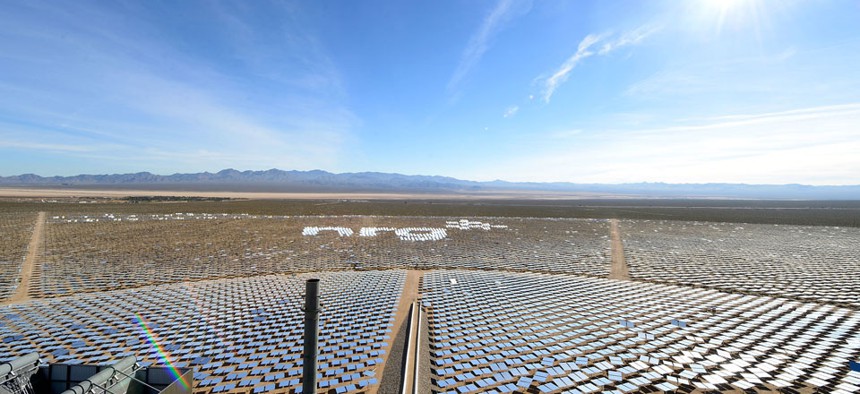Pilots Complain That Glare From the World’s Biggest Solar Power Plant Is Blinding Them

The Ivanpah Solar Electric Generating System Invision for NRG/AP
The 340,000 mirrors at the Ivanpah Solar Electric Generating System are reflecting sunlight up into the air.
Airplane pilots reported that they were blinded by the intense sunlight reflecting off some of the 340,000 mirrors at the Ivanpah Solar Electric Generating System on the California-Nevada border. Yet six months elapsed before their reports reached the regulator that oversees the plant, which is located near the Las Vegas airport.
The mirrors, called heliostats, focus the sun on 459-foot-high (140 meter) towers that contain water-filled boilers. The concentrated sunlight boils the water to create steam, driving turbines that generate 377 megawatts of carbon-free electricity. The heat is so blistering that it has melted the feathers of birds in mid-flight.
Planes fly far too high to be affected by the heat—but by not the light. “From the pilot’s seat of my aircraft the brightness was like looking into the sun,” reported one pilot as his small plane climbed from 6,000 to 12,000 feet after taking off from the Boulder City, Nevada, airport. In a report he filed with the Aviation Safety Reporting System (ASRS), the pilot wrote that, “In my opinion the reflection from these mirrors was a hazard to flight because for a brief time I could not scan the sky in that direction to look for other aircraft.”
He’s not alone. “Daily, during the late morning and early afternoon hours we get complaints from pilots of aircraft flying from the northeast to the southwest about the brightness of this solar farm,” reported an air traffic controller at an Federal Aviation Administration (FAA) center that monitors the airspace in southern California. A pilot of a commercial jetliner told him the light reflected from the Ivanpah mirrors “was nearly blinding.”
“I reported this to management and was told that they were going to do nothing about it,” wrote the air traffic controller to the ASRS, a 37-year-old program established by the FAA and NASA and administrated by the space agency in California. “I have no idea what can be done about this situation, but being a passenger on an aircraft that flew through this airspace and saw it for myself, I would say that something needs to be done. It is extremely bright and distracting.”
Here’s the scary part: The pilot and the air traffic controller filed their complaints in August 2013. But the reports did not reach the California Energy Commission, which oversees Ivanpah and other solar thermal power plants, until March 10, 2014.
The Ivanpah power plant, which counts NRG Energy and Google as its investors, is about 40 miles from the Las Vegas airport. The Clark County, Nevada, aviation department, which had previously expressed concerns about the potential for pilots to be blinded by the mirrors, received the ASRS reports in late January, spokesman Chris Jones told Quartz. But the aviation department didn’t forward the reports to the California Energy Commission until March, after it researched the issues raised by the pilots. Jones told Quartz in an email that he could not say whether flights out of Las Vegas had been affected by the glare.
The director of the ASRS program, Linda Connell, did not respond to a request for comment on why ASRS didn’t contact the California Energy Commission directly about the pilot reports.
ASRS receives more than 1,300 reports weekly from pilots, air traffic controllers and other aviation personnel, according to the program’s website. If the reports identify a hazardous situation, the ASRS issues an alert to the appropriate government agency.
BrightSource Energy, a company based in Oakland, California, built Ivanpah. “What I can tell you right now is that we take these concerns seriously,” Jeff Holland, a spokesman for NRG Energy, which is operating Ivanpah, told Quartz. He noted that the incidents occurred in August before the power plant went online and when workers were still testing and adjusting the heliostats. “We will respond to—and address—these reports in the coming days in accordance with conditions of our permits.”
Aviation officials have long been concerned about the impact of huge solar power plants, and in recent years the US military has vetoed the construction of projects near bases in the California and Nevada deserts.
Reprinted with permission from Quartz. The original story can be found here.
NEXT STORY: The World Wide Web Turns 25





